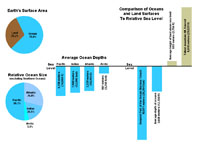1.2: The World Oceans
- Page ID
- 9689
\( \newcommand{\vecs}[1]{\overset { \scriptstyle \rightharpoonup} {\mathbf{#1}} } \) \( \newcommand{\vecd}[1]{\overset{-\!-\!\rightharpoonup}{\vphantom{a}\smash {#1}}} \)\(\newcommand{\id}{\mathrm{id}}\) \( \newcommand{\Span}{\mathrm{span}}\) \( \newcommand{\kernel}{\mathrm{null}\,}\) \( \newcommand{\range}{\mathrm{range}\,}\) \( \newcommand{\RealPart}{\mathrm{Re}}\) \( \newcommand{\ImaginaryPart}{\mathrm{Im}}\) \( \newcommand{\Argument}{\mathrm{Arg}}\) \( \newcommand{\norm}[1]{\| #1 \|}\) \( \newcommand{\inner}[2]{\langle #1, #2 \rangle}\) \( \newcommand{\Span}{\mathrm{span}}\) \(\newcommand{\id}{\mathrm{id}}\) \( \newcommand{\Span}{\mathrm{span}}\) \( \newcommand{\kernel}{\mathrm{null}\,}\) \( \newcommand{\range}{\mathrm{range}\,}\) \( \newcommand{\RealPart}{\mathrm{Re}}\) \( \newcommand{\ImaginaryPart}{\mathrm{Im}}\) \( \newcommand{\Argument}{\mathrm{Arg}}\) \( \newcommand{\norm}[1]{\| #1 \|}\) \( \newcommand{\inner}[2]{\langle #1, #2 \rangle}\) \( \newcommand{\Span}{\mathrm{span}}\)\(\newcommand{\AA}{\unicode[.8,0]{x212B}}\)
The World Oceans: Basic Geography Facts
- Oceans cover 71% of Earth’s surface.
- Oceans are interconnected (meaning that all water circulates through one world ocean).
- Oceans have huge size and volume (97% of Earth’s water).
The four principal oceans:
- Pacific (largest and deepest), Atlantic, Indian, Arctic (smallest and shallowest)
- Plus one: Southern Ocean (or Antarctic Ocean) - extension of oceans around Antarctica below 60° South latitude
Seas are:
- Smaller than true oceans
- Composed of salty water of varying salinity
- Partially or fully enclosed by land. For example the Yellow Sea is connected to the Pacific Ocean and the Red Sea to the Indian Ocean, whereas the Salton Sea and Caspian Sea are fully landlocked.
 Selected seas (discussed in this course) include: Mediterranean Sea, Adriatic Sea, Black Sea, South China Sea, Red Sea, Dead Sea, Persian Gulf, Caspian Sea, North Sea, Caribbean Sea, Bering Sea, and Sargasso Sea. Note there are many other "seas!" In addition, around North America are large oceanic embayments including the Gulf of California, Gulf of Alaska, Gulf of Mexico, and Hudson Bay.
Selected seas (discussed in this course) include: Mediterranean Sea, Adriatic Sea, Black Sea, South China Sea, Red Sea, Dead Sea, Persian Gulf, Caspian Sea, North Sea, Caribbean Sea, Bering Sea, and Sargasso Sea. Note there are many other "seas!" In addition, around North America are large oceanic embayments including the Gulf of California, Gulf of Alaska, Gulf of Mexico, and Hudson Bay.

Figure 1.5. Oceans depth and surface area compared with land.
Comparison of Ocean Basins and Continents
• Average depth about 3688 m (12,100 ft)
• Deepest area of the ocean: Mariana Trench in the Pacific: 11,022 m (36,161 ft)
• Average elevation of continents: 840 m (2,756 ft)
• Highest mountain: Mt. Everest 8850 m (29,935 ft)
See: Volumes of the World's Oceans (NOAA)
Topography is the measurement of the elevation on land. Bathymetry is the measurement of depth of water in oceans, seas, or lakes. Both topography and bathymetry are measure relative to the global average of sea level.


